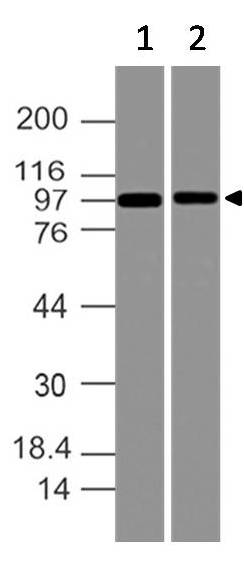Polyclonal antibody to RIP

Fig:1 Immunohistochemical analysis of RIP in formalin-fixed, paraffin-embedded tonsil using 20-1083 at 1:2000. A, low magnification overview of a secondary follicle. A1 and A2, sucessively higher magnifications of the germinal center from A. Hematoxylin-eosin counterstain.
Roll over image to zoom in
Shipping Info:
Order now and get it on Tuesday April 01, 2025
Same day delivery FREE on San Diego area orders placed by 1.00 PM
| Format : | Sera |
| Amount : | 50 µl |
| Isotype : | Rabbit IgG |
| Content : | 50 µl sera |
| Storage condition : | Store the antibody at 4°C, stable for 6 months. For long-term storage, store at -20°C. Avoid repeated freeze and thaw cycles. |
RIP (Receptor Interacting Protein) is a 74 kD Ser/Thr kinase which interacts with CD95 (Fas/APO1) receptor and the tumor necrosis factor receptor (TNFR1). It is a cell death domain adapter protein which can bind to the adapter proteins TRADD, RAID (CRADD) and TRAF2. RIP contains an N terminal region with homology to protein kinases, an intermediate domain capable of association with MAPKKK and a C terminal region containing an intracellular death domain motif. RIP activates both p38 MAP Kinase and SAPK families. In vitro, RIP induces apoptosis, as well as SAPK/JNK and NF-kB activation. NF-kB activation through TRADD, TRAF2 and RIP can be triggered also by DR3/APO3 upon activation with APO3/Tweak ligand. DR4 and DR5 also use FADD, TRADD, and RIP in their signal transduction pathways. RIP deficient mice fail to thrive, displaying extensive apoptosis in both lymphoid and adipose tissues and dying at 1-3 days of age. RIP possesses kinase activity as it autophosphorylates itself on serine and threonine residues.
WB: 1:1000-1:2000, IHC (paraffin): 1:1000-1:5000, IHC (frozen): Users should optimize, IP: 1:50-1:200
For Research Use Only. Not for use in diagnostic/therapeutics procedures.
| Subcellular location: | Nucleus, Cytoplasmic vesicle |
| Post transnational modification: | O-glycosylated. |
| Tissue Specificity: | Ubiquitously expressed. |
| BioGrid: | 109503. 43 interactions. |
|
There are currently no product reviews
|











.png)










